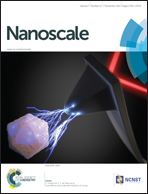Hydrophobic pocket targeting probes for enteroviruses†
Abstract
Visualization and tracking of viruses without compromising their functionality is crucial in order to understand virus targeting to cells and tissues, and to understand the subsequent subcellular steps leading to virus uncoating and replication. Enteroviruses are important human pathogens causing a vast number of acute infections, and are also suggested to contribute to the development of chronic diseases like type I diabetes. Here, we demonstrate a novel method to target site-specifically the hydrophobic pocket of enteroviruses. A probe, a derivative of Pleconaril, was developed and conjugated to various labels that enabled the visualization of enteroviruses under light and electron microscopes. The probe mildly stabilized the virus particle by increasing the melting temperature by 1–3 degrees, and caused a delay in the uncoating of the virus in the cellular endosomes, but could not however inhibit the receptor binding, cellular entry or infectivity of the virus. The hydrophobic pocket binding moiety of the probe was shown to bind to echovirus 1 particle by STD and tr-NOESY NMR methods. Furthermore, binding to echovirus 1 and Coxsackievirus A9, and to a lesser extent to Coxsackie virus B3 was verified by using a gold nanocluster labeled probe by TEM analysis. Molecular modelling suggested that the probe fits the hydrophobic pockets of EV1 and CVA9, but not of CVB3 as expected, correlating well with the variations in the infectivity and stability of the virus particles. EV1 conjugated to the fluorescent dye labeled probe was efficiently internalized into the cells. The virus–fluorescent probe conjugate accumulated in the cytoplasmic endosomes and caused infection starting from 6 hours onwards. Remarkably, before and during the time of replication, the fluorescent probe was seen to leak from the virus-positive endosomes and thus separate from the capsid proteins that were left in the endosomes. These results suggest that, like the physiological hydrophobic content, the probe may be released upon virus uncoating. Our results collectively thus show that the gold and fluorescently labeled probes may be used to track and visualize the studied enteroviruses during the early phases of infection opening new avenues to follow virus uncoating in cells.


 Please wait while we load your content...
Please wait while we load your content...